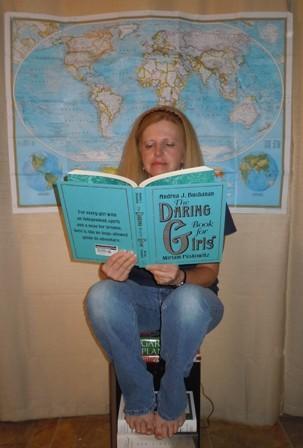Cheryl Hughes: Wrinkled
Did you ever sprinkle your clothes? Do you even know what I mean by “sprinkle your clothes?” Before the electric dryer and the steam iron, there were the clothes line, the dry iron and the sprinkler. Our sprinkler was a bottle with small holes punched in the lid. Tupperware made a fancier one—my aunt had one—but we couldn’t afford that, so we made our own.
After our clothes finished washing in the ringer washer, they were hung on the clothesline. More times than not, when they came off the line, the clothes had amassed a gazillion wrinkles. At the time, most clothes were made of cotton. When we got the lot into the house, we sorted them. Towels, wash cloths and underwear were folded, but we ironed most everything else, including sheets and pillow cases—don’t ask me why, I don’t know why.
Even though the ironing board was made to be folded up and put away, ours pretty much lived in the hallway. With seven kids in the family, somebody always needed something ironed—except on Sundays, my stepmom didn’t allow ironing on Sundays, which was fine with me.
After the ironables were separated from the non-ironables, the ironing began. I was seven years old and had to stand in a chair when Mom taught me how to iron. I remember only one mishap with the iron, but I still have the scar on my left hand. In those days you learned from your mistakes. The first things I learned to iron were my dad’s handkerchiefs. He worked at the sawmill and had to blow his nose a lot, so Mom laundered a lot of handkerchiefs. I graduated to ironing pillow cases then to skirts and finally to shirts and dresses.
During the ironing process, we would sprinkle down the clothes with the bottle of water—the sprinkler. The heat from the iron combined with the water on the clothes formed steam, and wrinkles are no match for steam. (It would be awhile before the invention of the steam iron.)
Sometimes, Mom would sprinkle down the clothes then roll them up and put them in the refrigerator to be ironed later. She did this during times when she had too many things going at once and something had to be put off. It was nothing out of the ordinary to have to shift some shirts to one side to find the left-overs in the frig. There’s no way I could get clothes to fit into my refrigerator. Even if I did, somebody would spill ketchup or chocolate syrup on them. That’s a given.
I think I was already in high school when drip-dry clothes hit the market. They were exactly what they sounded like they were—clothes you took directly from the rinse tub, put on a hanger, and let drip dry onto the front porch, back porch, smoke house or any place there was an empty nail that would support the weight of the saturated fabric.
The process worked alright during balmy weather, but it hit a bit of a snafu during the colder months. My school dresses would freeze stiff while blowing in the frigid winter air. “Get your dress off the porch and let it thaw by the fire so it will be ready for in the morning,” isn’t a phrase many school girls have heard. I did, more than once.
Before I graduated high school, we had a clothes dryer and permanent press fabrics. The ironing board was folded away behind the kitchen door, and ironing became a lost skill. Today, if my clothes have wrinkles in them, I usually just toss them in the dryer for a few minutes. Recently, Natalie asked if I could show her how to iron a blouse. I went through the process step-by-step—first the sleeves at the shoulders pulled over the small end of the board then the sleeves themselves then the back and the sides, and finally the collar. It was like riding a bike.
- Log in to post comments



























